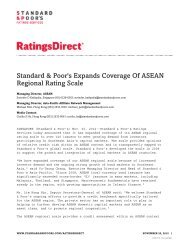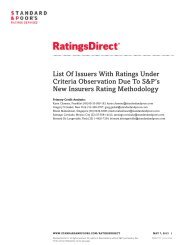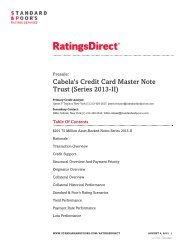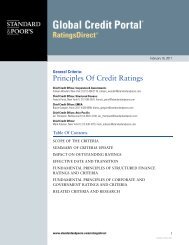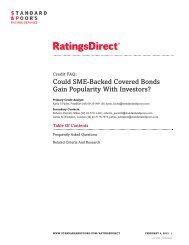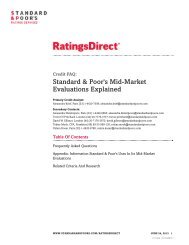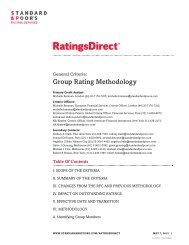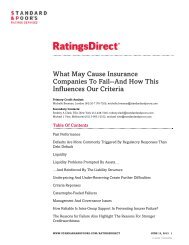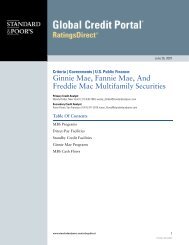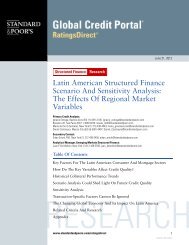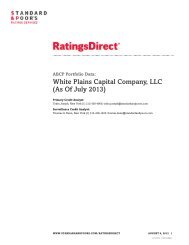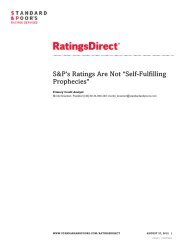Bank Ratings Incorporate Expectations For ... - Standard & Poor's
Bank Ratings Incorporate Expectations For ... - Standard & Poor's
Bank Ratings Incorporate Expectations For ... - Standard & Poor's
You also want an ePaper? Increase the reach of your titles
YUMPU automatically turns print PDFs into web optimized ePapers that Google loves.
We associate ranges of our projected RAC ratio with different capital and earnings assessments (see chart 2). <strong>For</strong><br />
example, capital and earnings are adequate when the projected RAC ratio is 7%-10%. Consequently, the capital<br />
and earnings assessment provides an indication of how we expect the RAC ratio to develop. If the historical RAC<br />
ratio is much less than 7%, and we view capital and earnings as adequate, one can conclude that we expect the RAC<br />
ratio to strengthen in the future.<br />
<strong>Bank</strong> <strong>Ratings</strong> <strong>Incorporate</strong> <strong>Expectations</strong> <strong>For</strong> Improving Capital Assessments Globally<br />
The more qualitative risk position assessment complements our view of a bank's risks by comparing the<br />
bank-specific risks to the standard risk assumptions that we use to calculate RAC ratios. In other words, a strong or<br />
very strong assessment indicates that our RAC ratio understates a bank's capital position. A moderate or weaker<br />
assessment means our RAC ratio overstates a bank's capital position. Risk concentrations and diversification are an<br />
important factor in the risk position, as is the complexity and changing nature of risks. This section of our analysis<br />
also considers the risks that we don't factor into the RAC ratio, such as potential mark-to-market write-downs on<br />
sovereign exposures, notably to Southern Europe, as well as interest-rate risk in the banking book and funding risk.<br />
(See the RACF criteria, "<strong>Bank</strong> Capital Methodology And Assumptions," published Dec. 6, 2010.)<br />
The Risk-Adjusted Capital Ratios Are The Starting Point <strong>For</strong> Our Capital And<br />
Earnings Projections<br />
The challenge of comparing regulatory capital ratios globally led <strong>Standard</strong> & <strong>Poor's</strong> to develop its risk-adjusted<br />
capital framework (RACF). The main quantitative output of the RACF is the RAC ratio. TAC represents an<br />
enlarged definition of the amount of capital a bank has available to absorb losses. It includes some hybrids subject<br />
to eligibility criteria and limits (see "<strong>Bank</strong> Hybrid Capital Methodology And Assumptions," published Nov. 1,<br />
2011). We derive our RAC RWA from globally consistent risk charges applied to on-balance-sheet and<br />
off-balance-sheet exposures. Our risk charges capture credit, market, insurance, and operational risk losses under a<br />
'A' stress scenario. (<strong>For</strong> detailed examples of <strong>Standard</strong> & <strong>Poor's</strong> stress scenarios, see Appendix IV of "General<br />
Criteria: Understanding <strong>Standard</strong> & <strong>Poor's</strong> Rating Definitions," published June 3, 2009.)<br />
Our capital and earnings assessments for 100 of the largest banks in the world, mostly based on the projected RAC<br />
ratios, correlate highly with the estimated RAC ratios as of September 2011 (see chart 2).<br />
<strong>Standard</strong> & Poors | <strong>Ratings</strong>Direct on the Global Credit Portal | February 29, 2012 4<br />
948538 | 300076937




